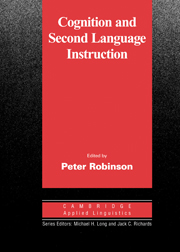Book contents
- Frontmatter
- Contents
- Series editors' preface
- Preface
- SECTION I THEORETICAL ISSUES
- SECTION II COGNITION AND INSTRUCTION
- 7 Cognition and tasks
- 8 Cognitive underpinnings of focus on form
- 9 Intentional and incidental second language vocabulary learning: a reappraisal of elaboration, rehearsal and automaticity
- 10 Task complexity, cognitive resources, and syllabus design: a triadic framework for examining task influences on SLA
- 11 Aptitude, individual differences, and instructional design
- 12 Cognition, instruction and protocol analysis
- References
- Index
7 - Cognition and tasks
Published online by Cambridge University Press: 05 October 2012
- Frontmatter
- Contents
- Series editors' preface
- Preface
- SECTION I THEORETICAL ISSUES
- SECTION II COGNITION AND INSTRUCTION
- 7 Cognition and tasks
- 8 Cognitive underpinnings of focus on form
- 9 Intentional and incidental second language vocabulary learning: a reappraisal of elaboration, rehearsal and automaticity
- 10 Task complexity, cognitive resources, and syllabus design: a triadic framework for examining task influences on SLA
- 11 Aptitude, individual differences, and instructional design
- 12 Cognition, instruction and protocol analysis
- References
- Index
Summary
Introduction
Unlike any other skill that you could care to mention (algebra, tennis, driving, playing the bagpipes), language can work well despite poor execution. Its meaning is recoverable even when its form is incorrect. ‘Me Tarzan, you Jane’, or ‘ET phone home’ are not grammatical, nor particularly subtle, but they get the job done. This useful characteristic of language means that learners can decode and encode the semantic contents of a message without attending to all of its syntactic packaging. Anderson and Lynch (1988), for example, show how contextual and discourse knowledge-sources enable comprehension to proceed for native and non-native speakers without exhaustive bottom-up analysis of a message. Schematic knowledge enables the redundancy in language to be exploited for meaning-extraction. Productively, it is clear that second language (L2) users draw upon a range of communication strategies (Bygate, 1988; Faerch & Kasper, 1983; Kasper & Kellerman, 1997) enabling them to communicate meanings despite limited resources. Individual case studies, e.g., of Wes (Schmidt, 1983) and Schmidt (Schmidt & Frota, 1986), as well as larger scale research such as that evaluating immersion education in Canada (Harley, Allen, Cummins & Swain, 1990; Swain & Lapkin, 1982) also indicates how the need to engage in output does not automatically lead to acquisitional progress. In evolutionary terms, it is entirely plausible that the language system should be robust in this way – requiring crystalline precision in all communication could well have been decidedly dangerous for our ancestors' health and survival.
- Type
- Chapter
- Information
- Cognition and Second Language Instruction , pp. 183 - 205Publisher: Cambridge University PressPrint publication year: 2001
- 167
- Cited by

